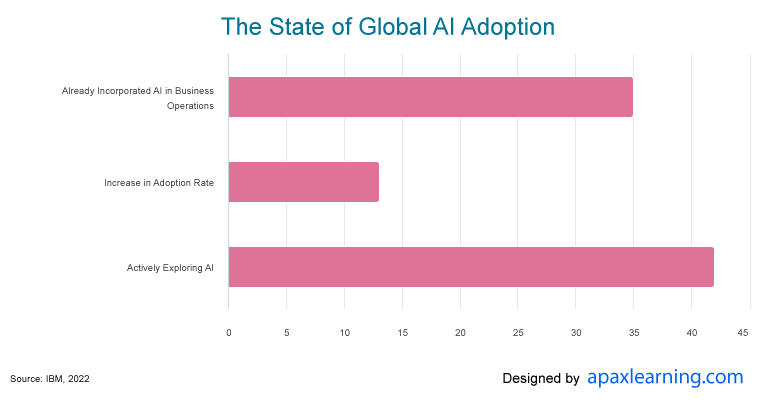In the ever-evolving landscape of digital education, eLearning authoring tools play a pivotal role in shaping the learning experience. These tools empower educators and instructional designers to create engaging, interactive, and personalized learning content. As we venture further into 2024, let’s delve into some of the exciting trends shaping the world of eLearning authoring tools.
Artificial Intelligence (AI) Integration
AI integration has gained significant traction, with 35% of companies already incorporating AI into their business operations. The adoption rate has increased by 13% compared to 2021, indicating a growing recognition of AI’s benefits to various industries. In addition, 42% of companies are actively exploring AI, highlighting its potential for further advancements in the future (IBM, 2022). AI integration in eLearning authoring tools can enhance content creation and delivery in educational settings. AI algorithms can analyze learner data, such as previous interactions and performance, to personalize learning experiences by adapting content and activities to individual needs and preferences. It plays a crucial role as an employee engagement platform. In addition, AI-powered authoring tools can provide intelligent recommendations for relevant resources, examples, and exercises, offering automated feedback to learners and helping them track their progress and improve.

Mobile Learning
Mobile learning has been growing in popularity for some time, and this trend is likely to continue into 2024. Mobile learning allows learners to access content on-the-go, and it is particularly useful for remote workers and those who travel frequently. eLearning providers that offer mobile-friendly platforms are likely to be more competitive in the market.
Mobile learning can take many forms, including mobile apps and responsive web design. By delivering content that is optimized for mobile devices, eLearning providers can make learning more accessible and convenient for learners.
Gamification and Interactive Elements
Integrating gamification in eLearning authoring tools can significantly enhance learner engagement and motivation, as evidenced by the projected growth of the global gamification market. With an expected CAGR of 26.5% between 2022 and 2027 (Mordor Intelligence, n.d.), gamification is recognized as a powerful approach to creating enjoyable and immersive learning experiences. Incorporating game-like elements such as points, badges, leaderboards, and rewards creates a sense of challenge, competition, and accomplishment, further enhancing learner motivation. Furthermore, interactive elements like quizzes, simulations, and exercises offer hands-on, experiential learning opportunities that actively involve learners and promote knowledge retention. By leveraging the growing potential of gamification and interactive elements, eLearning software can revolutionize traditional learning approaches, transforming them into dynamic and interactive experiences for learners.

Video based learning
Video-based learning is another trend that is likely to continue to grow in popularity in 2024. <strong>Video is an effective medium for delivering information, and it can be used to create engaging, interactive learning experiences.</strong> Additionally, video-based learning is accessible to learners of all skill levels and learning styles.
Video-based learning can take many forms, including recorded lectures, live streaming, and interactive video. By incorporating video into their eLearning platforms, providers can help learners to retain information more effectively and make learning more engaging.
Virtual / Augmented reality
Virtual and augmented reality are technologies that are starting to gain traction in the eLearning market. Virtual reality involves creating a simulated environment that learners can interact with, while augmented reality involves overlaying digital elements onto the real world.
These technologies have the potential to transform the way that we learn by providing immersive, interactive experiences.
Virtual and augmented reality can be used to create simulations that allow learners to practice real-world skills in a safe environment. For example, medical students can use virtual reality to practice surgical procedures, while industrial workers can use augmented reality to learn how to operate complex machinery. These technologies can also be used to create engaging, interactive learning experiences that help learners to retain information more effectively.
